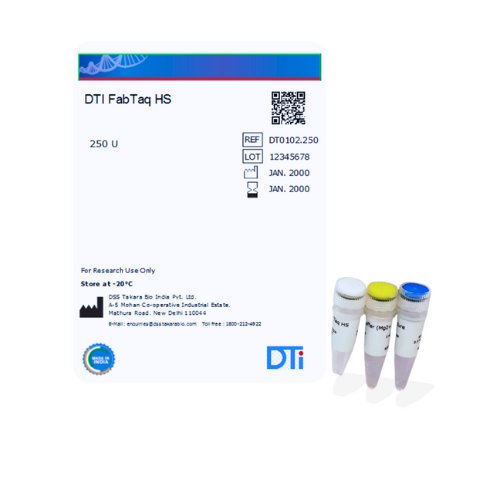DTI FabTaq HS
DTI FabTaq HS
DTI FabTaq HS DNA Polymerase is the hot-start version of our high-performing DTI FabTaq polymerase offering high yield, excellent sensitivity, and fidelity that is 4.5 times higher than Taq polymerase. Antibody-mediated hot-start gives lower background, higher specificity, and allows room temperature reaction assembly. DTI FabTaq HS DNA polymerase is supplied with 10X buffer (Mg2+) and dNTP mix.
SKU:DT0102.250

DTI FabTaq HS
| Brand | Catalogue Number | Pack Size |
|---|---|---|
| DTI FabTaq HS | DT0102.250 | 250 U |
- Antibody-mediated hot start Lower background, increased specificity, and room-temperature reaction assembly.
- High-yield and high-sensitivity PCR Ideal for demanding applications requiring maximum sensitivity.
- Excellent on difficult templates Provides consistent and reliable results on complex or challenging templates.
DTI FabTaq HS - Protocol and Downloads
| Document | Download Link |
|---|---|
| DTI FabTaq HS - Protocol | Download User Manual |
| DTI FabTaq HS - Certificate of Analysis | Download CoA - DT0102.250 |
| DTI FabTaq HS - Promotional Document | Download Flyer |
Results
Comparison with DTI FabTaq HS DNA polymerase
The performance of DTI FabTaq HS in a multiplex reaction was compared to its performance in single-target reactions, and to that of the standard DTI FabTaq DNA Polymerase in a multiplex reaction (Figure 1). DTI FabTaq and DTI FabTaq HS were each used to amplify a human genomic DNA template with eight different primer pairs, each specific for a target ranging from 84 to 432 bp in size. In addition, DTI FabTaq HS was used to perform an individual amplification reaction with each of the eight primer pairs.
The sample amplified using DTI FabTaq HS (Lane 10) shows more efficient multiplex amplification of all the bands individually amplified in Lanes 1–8 than the sample amplified using DTI FabTaq (Lane 9), and it lacks the low molecular weight non-specific amplification band seen with DTI FabTaq (Lane 9). The intensities of the bands in Lane 10 are comparable to the intensities of the corresponding individual bands in Lanes 1–8, indicating that DTI FabTaq HS provides multiplex efficiencies comparable to those observed in individual amplification reactions.

Figure 1: Comparison of DTI FabTaq and DTI FabTaq HS DNA polymerases in multiplex PCR reactions.
Comparing the ability of DTI FabTaq DNA Polymerase Hot Start Version to amplify human genomic DNA fragments to that of the standard DTI FabTaq DNA Polymerase. PCR reactions were performed using human genomic DNA as a template and primer pairs for eight different targets. Lanes 1–8 contain individual reactions for each primer pair amplified using DTI FabTaq HS. Lanes 9 and 10 contain multiplex PCR reactions performed with all eight primer pairs in a single tube, amplified with either the standard Taq DNA polymerase (DTI FabTaq, Lane 9) or DTI FabTaq HS (Lane 10).
Conclusions
This experiment demonstrates that target amplification efficiencies for multiplex PCR using DTI FabTaq HS are comparable to efficiencies observed for separate (single target) amplification reactions. In addition, DTI FabTaq HS demonstrates superior efficiency and specificity over standard Taq polymerase (DTI FabTaq) in this multiplex-PCR application.
Methods
PCR cycling conditions for individual reactions:
1 cycle at 94°C for 30 sec, followed by 30 cycles of 94°C for 30 sec, 55°C for 30 sec, and 72°C for 60 sec.
PCR cycling conditions for multiplex reactions:
1 cycle at 94°C for 30 sec, followed by 30 cycles of 94°C for 30 sec, 57°C for 30 sec, and 72°C for 60 sec, followed by a final step at 72°C for 90 sec.
FAQ - DTI PCR Enzymes
DTI JadeAmp FabTaq Premix can amplify targets up to 10 kb in length, including targets that are GC- or AT-rich. Additionally, PCR products generated with DTI JadeAmp FabTaq Premix can be used directly for restriction enzyme digestion, sequencing, or TA-cloning without the need for further purification.

